The Signposts Timeline:
The fabulous future of automobiles to come
(latest update of this section on or about 4-8-2001)




_________by J.R. Mooneyham_________
(Free JavaScripts provided by The JavaScript Source)
 2040s-2050s milestone; true 'automobility' finally becomes available to all
2040s-2050s milestone; true 'automobility' finally becomes available to all

FX-21 prototype by Daihatsu, Japan, circa 1996. |

Audi AL2 all aluminum concept car, circa 1997. |
Automobiles have changed a lot since the end of the 20th century. They have gradually transformed into hybrid hydrogen fuel cell/electric motive devices, capable of the equivalent of several hundred miles-per-gallon efficiency, with little more than water as an exhaust product. This is making refueling something perhaps done only once every few months or so for many drivers-- and so commercial 'gas' stations have been declining in numbers for decades. Some of the latest, pricier car models are hybrids in more than power sources; they also possess hybrid suspensions combining both hovercraft-like air cushions and fully electronic wheel carriages, which allow the vehicles not only higher cruising speeds and fuel efficiency, but all-terrain capacities-- including comfortable traversing of swamps and large bodies of water which would have stopped even the formidable U.S. Army HumVee vehicles of the late 20th century. The new technology suspensions also provide (on more conventional roadways) all wheel steering and drive, 360 degree turn radiuses no bigger than the length of the vehicle, and full sideways movement as desired for parking, etc. The hybrid suspension allows the car's wheels to 'tread lightly' in travel, via a variable mode where in ideal, dry, straight line long spans the air cushion serves as the primary contact with the road, with the wheels touching only sufficiently to steer; but on curves or during braking, etc., the wheels may press harder against the road (the air cushion deflates)-- in other words, the vehicle uses its air cushion to vary its effective weight and kinetic friction where contact with the roadway is concerned.
|
-- "Future cars offer good, clean fun: Fuel cells, hybrids are engines of tomorrow" by Paul Lienert, the Detroit News, 1-14-98
-- Expect rapid, pervasive innovation in 21st century, EurekAlert!, 2 DECEMBER 1999
Contact: Emil Venere
[email protected]
765-494-4709
Purdue University
-- Predictions for the new millennium By LANCE GAY, October 25, 1999, Nando Media/Scripps Howard News Service, http://www.nandotimes.com
-- Hybrid Vigor by Gregg Easterbrook, The Atlantic Monthly; November 2000; - 00.11; Volume 286, No. 5; page 16-18
|
Above illustration based on original image of Honda EP-X concept vehicle, circa 1992
Automobiles also have become electronic entertainment cocoons for everyone but the driver; but now the driver too gets to play passenger, as the latest automotive milestone is ubiquitous automated piloting; that is, cars drive themselves in all but the most exotic or unusual circumstances. Though large metropolitan regions often have highly redundant communications and control networks embedded in their traffic byways to aid individual automobile guidance, and also allow smaller, cheaper, and less autonomous vehicles to form the bulk of their native transport, most autos outside the major city areas are of the more expensive 'standalone' sort, capable of robust independent navigation all on their own, with only occasional help from navigational satellites and/or a network of traffic towers located over most developed countries.
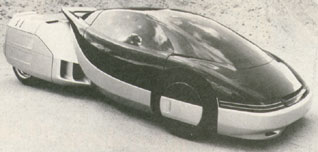
"Alien" show car by International Automotive Designhouse, circa 1986, offers interchangeable modular powerplants and other advanced features.
Of course, such automated piloting of autos didn't happen overnight, but gradually crept its way into mainstream autos, with such things as embedded 'governors' that simply wouldn't permit excess speed to be used casually or unreasonably frequently under certain weather conditions (wet, icy, fog, etc.) or traffic conditions (tailgating, too frequent high lateral G forces, etc.). Such governors also eventually came to recognize official speed limits in various metropolitan areas and major freeways/interstate highways-- thereby placing similar restrictions on plain old speeding. These governors were 'smart', allowing for some brief spurts of excess speed for normal traffic adjustment needs, but were also programmed to recognize abnormal speeding patterns. Many technologies contributed to the success of these governors, such as sophistocated new sensors, and greater communications between the auto's onboard electronics and the local traffic nets of various cities and major highways.
|
-- "YOUR CAR MAY BE SMARTER THAN YOU" By Otis Port in Detroit, with Larry Armstrong in Los Angeles, 6-29-98, Business Week]
30% of the costs involved in building top end autos in 2001 stems from their embedded electronics alone. Future car interiors will more and more come to resemble aircraft cockpits.
Cars may be driving themselves eventually, making for safer highways. So far however (circa 2001) technology may be causing as many accidents as it's preventing, due to generating ever more distractions for drivers. CD players, navigational help systems, mobile phones, etc., etc., may all be contributing to as much as 52% of all auto accidents around 2001.
-- Hit The Road, Chip By PETER CORDINGLEY (Bruce Rutledge and Yoko Shimatsuka also contributed to this article), FEBRUARY 23, 2001, Asiaweek, VOL.27 NO.7, asiaweek.com
Japan banned the use of handheld phones while driving just prior to 2000, and since then cell phone related auto accidents have been reduced by 75%. No matter how a mobile phone is accessed in a car, the risk of accident is four times higher when it's in use as compared to not.
(Mobile phones and other onboard user interactive electronics are referred to as telematics)
Workload managers for autos could automatically reduce telematic-related tasks for the driver as appropriate. I.e., rerouting phone calls to answering machines elsewhere during already stressful traffic or driving moments. Robust and reliable versions of such workload managers for autos look to be decades away however, as of 2001.
-- Reduce drive distraction, 13 FEBRUARY 2001, EurekAlert! Contact: Nancy Ross-Flanigan, [email protected], 734-647-1853, University of Michigan; http://www.umich.edu/~driving/index.html is a related URL.
|
Another interim step in automation arrived in the form of "platooning", which gave infrequent lengthy trip capabilities even to many limited urban cars which otherwise couldn't easily or conveniently venture beyond some 25 miles or so of home. "Platooning" was/is supplementary technology for auto owners wishing to transport their urban design vehicles cross-country inbetween cities. In many instances this may involve making an appointment with a commercial tow vehicle in the driver's home town. At the scheduled time you drive your small vehicle to the meeting place and it is integrated into a 'platoon' or 'caravan' of maybe a dozen of more vehicles like yours, placed according to their scheduled destination peel offs along the way. The wide diversity of autos in the 21st century means there may be several strikingly different ways platooning may be accomplished. In the most advanced, no mechanical connection between vehicles is necessary: the tow vehicle remotely controls all other vehicles electronically as one long snake-like transport, with each individual vehicle maintaining an intimate position with all others at virtually all times (often with only inches of separation). Precision computer control of steering, throttle, and brakes on all vehicles involved makes this perfectly safe-- even in the event of spontaneous equipment failures on one or more vehicles. But other methods are available as well (such as involving mechanical connections and the like).
Certain configurations of vehicles and platoons can even be refueled without stopping, by a certain point during this period.
|
-- "AUTO2010" by Paul VanValkenburgh, found on the web on or about 7-11-98
|
Of course, beyond a certain point autos designed for local use become so cheap and plentiful in many regions that it becomes almost unheard of for anyone to actually take their own urban auto on journeys between distant cities. It'd just be too slow, cumbersome, inconvenient, costly, and unsafe-- compared to the alternatives. People increasingly drive an urban auto to a local high speed train stop or air shuttle station, leave it, zip to their destination, and use another car available at the remote location to get around there. Low rent autos are increasingly abundant in some places today, in small parking lots located maybe every couple city blocks. The cost? Maybe one to five dollars a day in the currency of the time-- including minimal insurance and a basic fuel allotment (say 20-40 miles daily equivalent, with more costing extra).
|
-- "Alternative Cars in the 21st Century: A New Personal Transportation
Paradigm" by Robert Q. Riley (published by the Society of
Automotive Engineers (SAE)) (found on the web on or about 7-11-98)]
-- "Futurists gather to predict world's turns" BY BOB KURSON STAFF REPORTER, Chicago Sun Times, 7-20-98
|
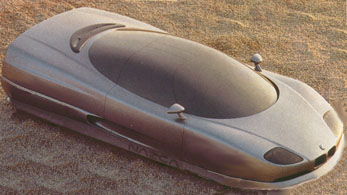
The illustration above began with an original photo of a circa 1991 show car created by ItalDesign/Giugiaro and BMW.
The transition of the world from gasoline power to hydrogen power takes a toll on the economic fortunes of oil producers, perhaps hastening the fate described elsewhere in this document for certain states.
The cost of mobility has declined dramatically, with city citizens enjoying the cheapest transport options of all. Two contributing factors have been the vast new intelligence and other technologies now built into autos, making them much safer and more efficient, enabling governments/manufacturers to dispense with many old regulations concerning bumpers, crash-worthiness, and pollution-control, which all tended to raise the cost of ownership and operation. In many cases shifting safety costs out of personal vehicle construction and into the actual thoroughfare infrastructure itself proved much more practical and cost-effective.
EXAMPLES: Under some circumstances, in densely traveled routes where speeds tended to be on the high side, and relatively few cars computer-piloted, special traffic governing vehicles would automatically distribute themselves among the traffic flow in a continuous cycle, limiting the overall speed of the flow as well as forcing a certain spacing between traffic clusters. These typically large vehicles would manage traffic flow like cowboys herding cattle. Their size also allowed them to perform other useful functions such as hauling private or public supplies for short distances. The contents of such shuttles usually would be limited to non-explosive, non-flammable, non-toxic, impact absorbing materials so that in the case of a chain collision the vehicle itself would help mitigate the effects on vehicles before and after it. Explosive impact absorbing foams were also deployed along the sides of some roadways and within highway splits. Similar to the water barrel barriers deployed decades earlier, these foam barriers offered advantages such as greater fire dampening effects compared to plain water, and more impact absorbing power. The foaming action would also sometimes protect initial collision victims from secondary collisions by forming encompassing foam buffers against incoming vehicles. They were also much more compact in storage than plain water, to provide the same level of impact mitigation. The flourescent lime green color of the foam gave better visibility and warning of the event to following cars than plain water even in fog or at night. Foam deployments automatically alerted authorities to a crash, as well as immediately began diverting upstream traffic to safer contingencies. Crash foam expands to full size within seconds of triggering, and collapses back into non-toxic, biodegradeable liquids within about a minute or so of expansion completion. END EXAMPLES.
Global competition and rising productivity have also reduced the cost of autos, even as slackening demand has cut into profit margins too. Most autos of this generation are highly recyclable, making total cost lower still. Repair costs have fallen sharply, as have related insurance costs. Another factor in many locales has been the greater functionality of daily clothing-- that is, high tech clothing now often performs many duties related to comfort and safety for the wearer, that decades before were expected of the automobile itself. This has relieved the burden on vehicles for some features, making them cheaper still in many areas as a result.
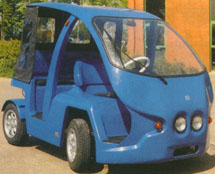
The Solar Baby electric car from Frazer-Nash
Research Ltd., of the United Kingdom, circa 1996 |
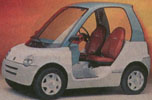
Neighborhood Electric Vehicle
design by Bombardier, circa 1997 |
The past titans of automobile manufacturing (such as Ford, GM, Toyota, etc.) are now facing a growing competitive threat from companies whose predecessors once produced only electronic items such as PCs (personal computers) in the late 20th century. One major reason is the declining importance of purely mechanical drive-trains and/or internal combustion engines relative to electronics in a modern automobile's composition. Though the marketshare of the 20th century's electronic industry progeny remains below 10% worldwide at this time, it is expanding, and the companies are aggressively pursuing the old auto industry's markets. This pressure is accelerating innovation and diversity in the global auto industry as a whole, as well as putting downward pressures on the cost to consumers.
|
-- "YOUR CAR MAY BE SMARTER THAN YOU" By Otis Port in Detroit, with Larry Armstrong in Los Angeles, 6-29-98, Business Week
PC companies are accustomed to growing by 20-25% a year. To continue this rate of growth they will be forced to move out of desktop computers and into the mobile environment.
-- Beyond the speed bump By Wes George, February 14, 2001, MacWEEK, Mac Publishing LLC.
|
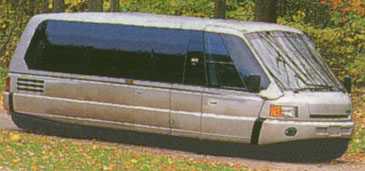
Above image based on photo of the MSV 1120S Mini-bus by Mauck Special Vehicles of Columbus Ohio, USA, circa 1997
Fantastically equipped full-sized RVs are replacing large luxury automobiles in the hands of private citizens. 20th century observers of this time would surely be surprised at the growing average size of common luxury vehicles now. People who in 1990-1995 might have bought something like a 21 foot long Cadillac or Lincoln Town car now buy something more like the 30 to 60 foot recreational vehicles of 1990-1995 instead. These behemoths are often being bought for general transport/living purposes now, rather than merely vacation travel. Their intelligent, articulated electronic suspensions and other driving aids make piloting and parking the giants much easier and more practical than in previous decades. Purchase and maintenance costs are much lower compared to older examples, too. And the convenience and utility of today's large personal consumer transports would astonish car watchers from 1997. New technology is making it possible for today's vehicles to be reconfigured in ways that offer their owners an amazing array of options. When stationary, interior space can be expanded in miscellaneous ways to double, triple, and even quadruple in size-- sometimes adding a full second story to the movable home, for example. And these volume expansions of this class of vehicle are not based on the shoddier and less reliable means used for such capabilities in the waning years of the 20th century; the new transports are brutally superior to their predecessors. Interior furnishings and appliances may slide behind protective walls to transform part or nearly all of such a vehicle into a large enclosed truck for transporting cargo. Near complete closed system recycling of many consumables is available in some models for extended stays in the wilderness. Substantial solar power options are built-in. GPS (Global Positioning System) capabilities, satellite-based telephony, web dial tone, and digital TV are standard. Many of these large vehicles also possess their own much smaller two, three, or four wheel auxiliary vehicles too, for local errands and other contingencies.
There's many factors driving the sales of these large, truly mobile homes/offices/studios-- below are a few:
One, the general price deflation and technological innovation/competition affecting many areas of the world economy have been slow to bring about the same scale of changes in real estate prices and traditional home costs, compared to other items. So many people simply cannot afford to go the traditional fixed home route. In contrast to real estate and labor-intensive onsite construction, and a few raw material resources, costs of manufactured goods have been under mostly steady downward pressure since the turn of the century. Apparently the stunning cost deflation which was first seen in general electronics and personal computers is now working its way through many other aspects of human endeavor.
Two, employment, education, and training have all been undergoing enormous flux the past several decades, in the developed nations. Virtually no one expects to have the same employer their whole life anymore-- even having the same job for longer than a couple years seems far fetched to many. And although net-based education has radically reduced the dependence of students and instructors on physical institutions, other factors have made relocations related to continuing education still important to many. Major employers have also managed to greatly reduce their real obligations to many of their employees in matters like health insurance and pensions as well, due to continuing 'deregulation' by many governments and the somewhat misguided policies of allowing brutally free rein to economic forces in the 21st century. In many cases today (though not all), the perception is that it's 'every man for himself'. And this has led to a boom in self-employment and entrepreneurism, as well as a desire by employees in general to keep their options as open as possible at all times. By living in a reasonably modern incarnation of a 1998 RV and owning no fixed piece of property, it's easier, faster, and cheaper to change jobs and locations as circumstances dictate.
|
-- The Millennial Mind-Set by Annetta Miller, American Demographics, January 1999
One recent study suggests that workers in the internet content field (or 'new media')get bigger raises by changing jobs rather than sticking to one. Full time workers surveyed said they averaged two different jobs in the past year. More independent workers (contractors), reported six different jobs in a year.
Insecurity runs high in this field, for both employers and employees, partially because of few real standards or suitable testing procedures. This may explain the high employee turnover and tendency towards long work hours. In this environment there's little job loyalty or security, and score is often kept by income level.
-- To save your job, hop around?
By Brian Livingston
February 2, 2001, CNET News.com
|
Three, with the rise in entrepreneurism and self-employment, a mobile 'office' and/or meeting place also comes in handy for many business-related reasons.
Four, aging populations in many of the developed nations much prefer the convenience and comfort of a large well equipped motorized home over the cramped motor cars of previous decades.
Five, increasing pollution problems in many areas, as well as often stunning discoveries about previously unknown toxic waste dumps, and periodic environmental scares from terrorist or criminal action (or plain old industrial accidents) makes a readily movable home a most attractive option in the mid-21st century.
Six, living in a truly mobile home also provides significant tax breaks and increased privacy and security options in the mid-21st century as well. It's much easier to pick and choose your preferred local tax, surveillance, and regulation environment for business and investing purposes, as local government policies everywhere fluctuate over months and years. Personal or business or activist web site servers might often benefit from rapid relocation to escape local natural disasters, sudden censorship, or other adverse circumstances, such as corporate or government searches and seizures, or even harassment/assault by competitors. In other words, the owner of a mobile home today enjoys at least some perks similar to the legal and physical advantages of someone living on the open sea in a boat in the late 20th century. Of course, they also face similar dangers in some respects too.
Seven, though geopolitical states are only beginning to suffer competition from the newly aborning virtual states, still there's real and major changes in sovereign governments and borders and national economies happening frequently during the entire 21st century. These changes in some cases make the option of leaving a country entirely with all your possessions (and with only hours or days notice) enticing indeed for many.
Eight, supporting industries and infrastructure for such RV living has been steadily growing for decades, thus making the concept ever more attractive and practical. For instance, now there exist exclusive net-based communities for those living aboard RVs, and large gated physical communities of RV warehouse-like resorts where RV owners may rent or lease protective shelter/enclosures and utility connections for their vehicles, for as short or as long a period as desired, and also enjoy many local amenities such as swimming pools and other things too during a stay.
Another deepening bit of infrastructure here lies in personal housing. During this time of transition in terms of work, recreation, and family, storage spaces such as warehouses and mini-warehouses flourish. Fixed site homes continue to be popular, but increasingly they are diverging into very small and compact dwellings meant for only one or two residents, or large structures intended for sharing among a single large extended family or several smaller families, or a like-minded group of individuals.
In other words, many people today are increasingly living away from their 'permanent' fixed site homes for lengthy periods, either in smaller efficiencies or motorized vehicle homes, for purposes of work. Many people today also take lengthy sabbaticals (either by choice or not). The motorized vehicles offer a handy medium for recreational trips too, but most people will spend extensive off-time in their large communal fixed site homes. The erratic schedules of all involved mean that often only one or a fraction of the group will have the large house all to themselves for weeks or months at a time-- sometimes years. Rarely will the home will left unlived in. This helps protect the house and its contents for all the inhabitants while offering a sense of permanence in an increasingly rapidly changing world. Residents sharing homes tend to be related by family, or very close friends or business partners.
Note that the trend towards larger, shared homes will also help support the expanding needs of the self-employed and telecommuting classes, and spread the expenses and maintenance of related equipment, services, and other resources across a wider number of individuals, making the overall burden less for everyone (in the best cases).
Many of the trends described here could be seen emerging as early as the mid to late 20th century, with the rising popularity of motorized homes and travel trailers, RV parks/resorts, mini-warehousing, house sitting, time shares, condominiums, telecommuting, many more couples living together as opposed to marrying (compared to earlier times), and more.
Other portents included the increasing specialization of expertise even within families and circles of friends. Years before 2000 it was becoming practically a necessity to have a family member or friend well versed in computer equipment troubleshooting, repair, and upgrades. Having another with similar expertise in regards to automobiles was an even older nicety. Carpentry, plumbing, and electrical work? Still more very desirable in-house skills, and even longer in demand than auto experience for folks living in the developed nations. Child rearing, education, and supervising? Cleaning, organization, and scheduling? Home supplies purchases and budgeting? Conflict arbitration and negotiation? Motivation and counseling? All skills essential to the human condition since civilization began, and increasingly valuable to its future.
With the advent of the web, a good net researcher became yet another asset to a household or business. As the paperwork burden increased around the turn of the century, and the wealth and investments of many households expanded, portfolio management and household budgeting also became valuable home/small business skills. In many close groups practically all these skill sets (and more) could well justify its own specialist within a household organization.
This is not to say that all families/households were becoming wholly self-sufficient in the 21st century, and thereby killing the markets for professionals in all these fields. Rather, such small groups/organizations were being forced by circumstances and cost-efficiency to limit their use of outside agencies for reasons of convenience, costs, speed, quality, and an ever dwindling amount of personal free time. Frequently dealing with outside contractors has simply become too heavy with overhead for many groups now, even where the rising costs are of no concern. Ergo, the increase in self-sufficiency. Keep in mind too that as more and more folks these days are effectively self-employed, their very jobs tend to have helped them gain the expertise necessary to perform well in many of these fields as needed. And members of such a household often tend to cross-train one another in such skills, over the years.
Another worthwhile point here: Many, perhaps all, of the skill sets described above were expanding in potential utility and applicability during the early years of the 21st century. Net researchers for instance could aid and advise home supply purchasers as to the best products and services according to rating sites on the web. They could also look up health ailments and offer potential treatment information for some maladies, while also alerting their companions to potentially dire conditions requiring a visit to a doctor. They could locate obscure information regarding certain auto and other equipment repairs. Etc., etc., etc.
Nine, Virtual Reality and telepresence technologies of ever increasing quality are by now being used almost across-the-board in mid-range to high-end environments to make smaller quarters seem more spacious, inner city apartments 'look and feel' like vast isolated country estates, and tiny exercise cubicles seem like the voluminous personal gymnasiums of wealthy celebrities. These VR technologies are also used extensively in the latest mid-range and up automobiles and RVs-- thereby making the vehicles much easier to live in and around for indefinite periods of time.
AUTHOR'S NOTE. Recall the description before of many people living in motorized homes for work purposes but sharing a permanent (if remote) large fixed site home with friends, family, and/or business partners? Today's telepresence technologies allow such folks far from 'home' to instantly drop in at the house virtually during their off-hours from work. So in many intellectual and psychological ways folks can work thousands of miles from home and still be with their loved ones every night. (Of course where the telecommunications involved suffer bandwidth problems or must cover distances as great as half a planet some qualities of the contact may be compromised; i.e., a certain lag time in responses may be noticable, similar to that seen in remote TV newscasts circa 2000) END NOTE.
Ten, the increasing shortage of free time, the increasingly crowded living conditions of many cities, frequent traffic jams, and the inconvenience of long commutes between home and office, is driving up demand for 2nd and even 3rd homes for many folks, with some workers even keeping small houses or apartments near work for weekdays, and going to their real homes only on weekends. The pricey nature and inflexibility of fixed housing compared to parkable mobile shelter however leads many to purchase an RV instead, to gain a highly liquid functionality of an 'extra house' at relatively low cost. Traffic and commute problems are minimized by simply moving the vehicle as rarely as possible.
|
-- "Detroit's Impossible Dream?", Business Week (on or about 2-19-98), April 27, Business Week: 1998 Personal Business: "Finding an Office-On-Wheels", "SIX DAYS IN A ROLLING HOME", "TAKING YOUR DESK ON THE ROAD", "Car Makers: The New Greens", Los Angeles Times (datestamp 3-1-98), "Imagine, car engines powered by only sunlight and water; Two researchers say they have refined the process for producing hydrogen
from water with solar power", by H. Josef Hebert,
ASSOCIATED PRESS, April 17, 1998, "Pacific Northwest National Laboratory
Environmental Technology Breakthroughs Forecast -- Year 2008", 20 APRIL 1998, "Small and Slow ... but Clean", Wired News, 4-30-98
Super reliable 'permanent' or 'immortal' parts for automobiles and other machinery may be on the way. Side-benefits may include lower costs across-the-board for such devices than today (1999), as well as reduced pollution from related manufacturing.
-- ScienceDaily -- New Math Method Adds To Likelihood Of Super-Reliable Metal Parts, 8/18/99, Purdue University, http://www.sciencedaily.com//releases/1999/08/990817064702.htm
Americans in general move to new homes about once every five years.
Asian and Hispanic Americans move every three years on average.
-- Americans hop to new nests about every five years, study says, October 29, 1998, CNN/The Associated Press
-- Predictions for the new millennium By LANCE GAY, October 25, 1999, Nando Media/Scripps Howard News Service, http://www.nandotimes.com
|
The above article(s) come from and make references to a collection copyright © 1993,
1994, 1995, 1996, 1997, 1998, 1999, 2000, 2001, 2002 by J.R. Mooneyham (except where otherwise noted in the text). Text here explicitly authored by J.R. Mooneyham may be freely copied and
distributed for non-commercial purposes in paper and electronic form without charge if this copyright
paragraph and link to jrmooneyham.com are included.
Back to J.R.'s
WebFLUX Page (the magazine)
Back to J.R.'s
WebWork Page (A general web index)
Site Map for the
WebFLUX and WebWork pages











 2040s-2050s milestone; true 'automobility' finally becomes available to all
2040s-2050s milestone; true 'automobility' finally becomes available to all





